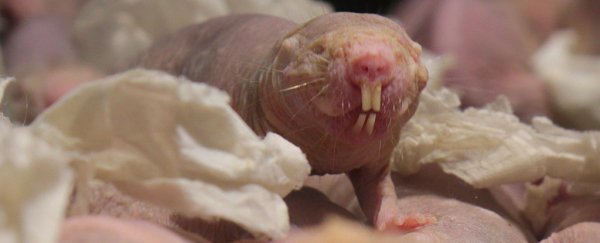We already know what a tough and hardy little creature the naked mole rat (Heterocephalus glaber) is, but it turns out these critters do have a weakness after all – they rely on high levels of carbon dioxide in their immediate environment, otherwise they have seizures.
While previous studies have already identified the animal's ability to survive without oxygen and live in CO2-heavy environments, this new research goes further, showing that the carbon dioxide is actually key to the creature's health and wellbeing.
It turns out that a genetic mutation explains this reliance on CO2, and researchers think that these findings might eventually help us find better treatments for humans who suffer from seizures and similar neurological conditions.
"While [naked mole rats] thrive in their cramped nest quarters, the air composition just above the surface of their burrows in East Africa makes them vulnerable to seizures," says neuroscientist Dan McCloskey, from the City University of New York (CUNY). "Because that's what happens when naked mole rats lose carbon dioxide."
The tendency for naked mole rats to stick close to home, and close together in their burrows (known as eusociality) has already been well reported. It turns out that the extra carbon dioxide that this close-quarters living brings is actually calming to their brains.
When the rats reach the fresh, oxygen-rich air of the outdoors, their minds start to race – which can bring on seizures, and encourages them not to venture too far from the crowded burrows.
The researchers were able to track down the cause of the CO2 dependency to a common genetic variant called R952H, which in turn affects the KCC2 protein that's responsible for regulating the amount of chloride in the brain's neurons.
With KCC2 no longer functioning as normal, the chloride can't do its usual job – keeping neurons calm and quiet when necessary – and so the brains of the naked mole rats have this tendency to go into overdrive and seize up.
"The identification of the genetic polymorphism in the naked mole rat KCC2 was a surprise," says neuroscientist Martin Puskarjov, from the University of Helsinki in Finland. "Aside from a small subset of humans, naked mole rats are now the only other mammals known to harbor this variant."
And that link to humans could be important: scientists might be able to apply what they've just learned about the naked mole rat to better manage seizures in people who have the same genetic mutation.
Humans with the KCC2 variant that matches what has been discovered in the naked mole rats can be prone to febrile seizures, and the same variant can also be found in people with idiopathic generalised epilepsy, schizophrenia, and autism.
Further tests using the anti-seizure drug diazepam showed that it actually induces seizures in naked mole rats, backing up the idea that the animals are making use of excess carbon dioxide in the atmosphere to compensate for the chloride imbalances caused by R952H.
In other words, the default setting for a naked mole rat brain is to be more uninhibited than is really safe. It's the pull of the CO2-rich environment that leads them back to the nest and to their community, where that brain imbalance can be corrected.
"Naked mole rat brains lack some of the inhibition that a mammal needs," says neuroscientist Michael Zions, from CUNY. "Instead, they're using the carbon dioxide to get back to where they have to be."
"They prefer CO2 levels that would panic a person, but are troubled by fresh air. They've leveraged a liability to literally dig themselves a niche."
The research has been published in Current Biology.
